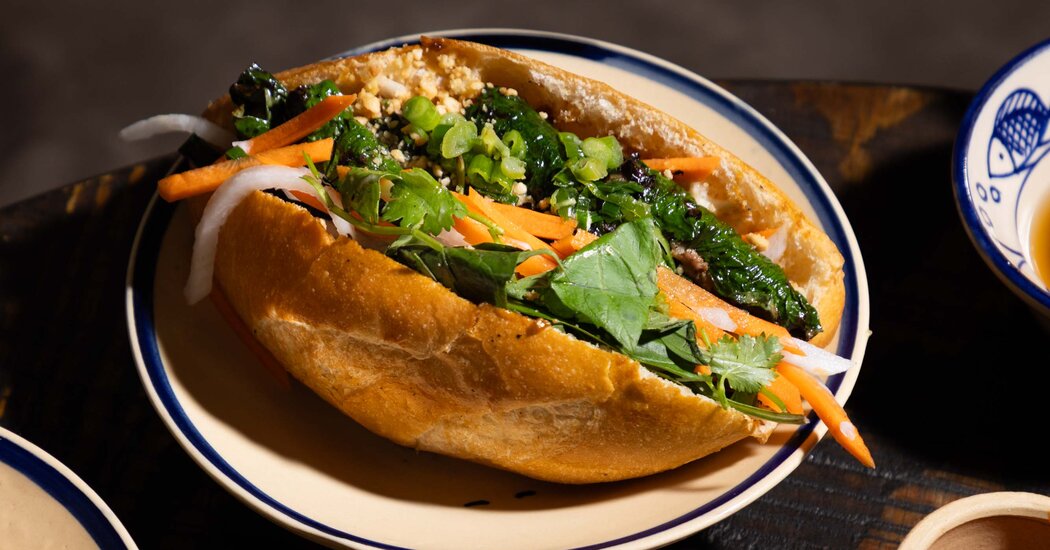Copyright The New York Times

It is not madness, not quite. But the kitchen at Bánh Anh Em in the East Village is atilt, everyone intent, all hands at speed in the constant steam, wielding tongs, ladles and cast-iron skillets like extra limbs. Racks of loaves, slashed before baking, bloom and gape in the oven. Broth trembles in a giant vat streaked black from constant heat. You can smell the char in the air, from the red-hot coals in the open grill — the same char scented in the great street-food cities of the world, where down some alley whose name you’ll never know, cooks hunched over the most jury-rigged equipment turn out dishes you’ll remember your whole life. For years, the place to go for Vietnamese food in the United States — in its widest range, in all its regional variations — has been Orange County, Calif. More than 100,000 Vietnamese refugees settled there in the decades following the American withdrawal from Saigon in 1975. In New York City, where their numbers have been much smaller, early Vietnamese restaurants were mostly run by members of the country’s ethnic Chinese minority (who found support for opening small businesses in Manhattan’s Chinatown), and drew from their culinary traditions. Bánh Anh Em opened in March as part of a newer generation — going back to the punk-ish pioneers An Choi on the Lower East Side in 2009, and Bunker in Ridgewood, Queens, in 2013 — seeking to broaden understanding of Vietnamese cuisine. The chef, Nhu Ton, and her business partner, John Nguyen, met nearly a decade ago through his aunt, Anh-Tuyet Nguyen, who always kept an eye out for young Vietnamese immigrants “trying to find their place in America,” he told me. (She died in 2020.) There’s some overlap with the menu at Bánh Vietnamese Shop House, their five-year-old restaurant on the Upper West Side. But Bánh Anh Em is more expansive and ambitious, with almost everything made in-house — bread for bánh mì, crackling then caving; ruốc tôm, shrimp boiled, oven-dried then worked by hand into a loose wool; chiles simmered into the rare hot sauces that prize flavor as much as heat. That doesn’t mean it’s cozy or somewhere you want to linger. The scrappy spirit of street food prevails. Bánh Anh Em does not take reservations, and lines form at least a half-hour before service, so every seat gets filled at once, a slam that never lets up. There are tables in back, in a breezily disheveled room of naked pipes and walls skinned of plaster. But I would choose the counter by the kitchen, just to watch the cook who makes bánh cuốn to order, briskly ladling the batter onto a cloth drawn taut over a steel frame atop a steaming pot. A few swirls with the ladle’s bottom, a pop of the domed lid, and then she fearlessly slips a flat bamboo rod under the round of dough and lifts. Half noodle, half crepe, the dough clings and droops, but doesn’t tear. This is daily labor; this is mastery. For Ms. Ton, this is also childhood. She grew up in the central highlands of Vietnam. When her family fell on hard times, she was sent to live with her grandmother, who made bánh cuốn for a living, soaking the rice overnight. Ms. Ton helped by gathering wood from the forest as fuel for the fire. At the restaurant, she has devised her own technique, fermenting rice flour for up to a week to break down the starches, so the finished sheet is ultra-tender and almost gelatinous — a comfortingly earthy backdrop for wood-ear mushrooms, chopped fine but still retaining their bounce, and ground pork, tucked inside; Midas-touched shallots; sun-tinged cilantro; and the happy sting of nước chấm (fish sauce spiked with sugar, and lime-bright), for dipping. Rice sheets appear across the menu. Order bánh uớt chồng and you get a tower of them, limp kerchiefs to roll up around flaps of pork jowl and pink strips of cured beef. Two fish sauces are provided; I preferred the funkier mắm nêm, a disintegration of anchovies, frank and unfiltered, with a scent to conjure the boneyards of the deep. Bánh beo are mini rice cakes in individual saucers under clottings of ruốc tôm — delicious, although I wished they were less dense and more slippery, like ones I once had the fortune to eat in Huế, as slurpable as oysters. Bánh xeo, stained yellow by turmeric, is porous, with the edges fried hard, so that shards rain down from each bite, yet almost gooey at the center, where it’s packed close to bursting with pork and shrimp. Plenty is a theme. Bò né is a sizzling heap of steak and eggs upstaged by two kinds of pâté, punchy with salt and swamping the plate, unbeautiful and addictive. Supersized bánh mì brim over with the likes of betel-leaf-bound ground beef, smacking of mint, or chà bông, pork dried and fluffed, like creeping moss. In Vietnam, you wouldn’t eat all these dishes at one place. More likely, you’d go to a specialist for each, like the vendor under a bridge in Hanoi whose bún chả Ms. Ton recalled for me with a sigh. Her version is memorable, too: juicy patties of pork jowl leaching smoke into nước chấm until it tastes as if the liquid itself had gone through fire. So it’s too much to expect perfection of every dish. Ms. Ton has had to scale back some of her dreams, like making noodles in-house. (She tried, but couldn’t keep up with the orders.) The kitchen has only one vat for phở, and must often alternate between phở bò (beef) and phở gà (chicken). No matter: Either makes a fine meal. Some might find the beef broth too fatty, but in a darkening season, this can feel like a blessing. One day I ordered just broth to go, and it was still piping hot after a half-hour on the subway. I gulped it straight from the plastic tub, standing in my kitchen, feeling it line my insides, fattening me up, and I thought: Let winter come. Follow New York Times Cooking on Instagram, Facebook, YouTube, TikTok and Pinterest. Get regular updates from New York Times Cooking, with recipe suggestions, cooking tips and shopping advice.



